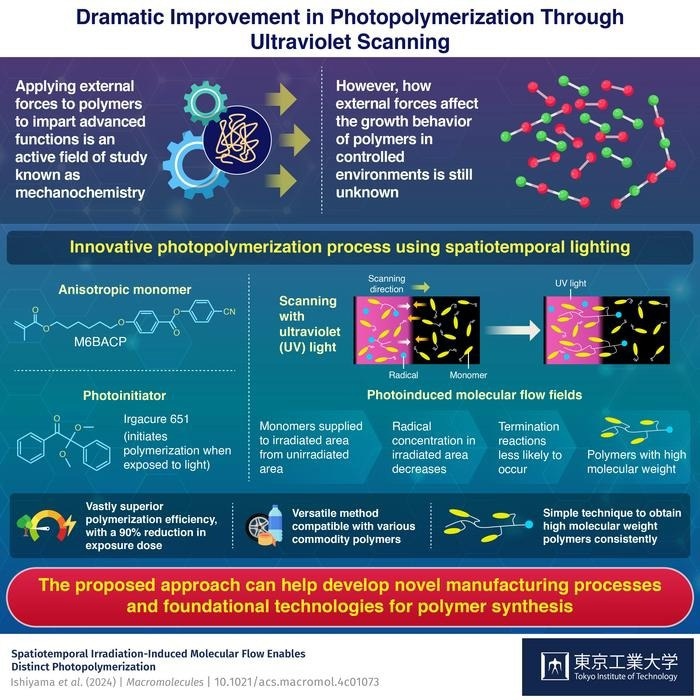Reviewed by Lexie CornerAug 20 2024
Researchers at the Tokyo Institute of Technology explored how flow fields generated by dynamic UV lighting can affect the photopolymerization process, demonstrating a novel and versatile method for controlling polymer synthesis. Their study was published in Macromolecules.
 The proposed approach can help develop novel manufacturing processes and foundational technologies for polymer synthesis. Image Credit: Tokyo Institute of Technology
The proposed approach can help develop novel manufacturing processes and foundational technologies for polymer synthesis. Image Credit: Tokyo Institute of Technology
Polymers are materials composed of long, repeating chains of molecules, and the interactions between these chains largely determine the polymer's physicochemical properties. The intuitive understanding of polymers, which goes back to the 1930s, primarily views external forces acting on polymers as harmful. Stretching a polymer, for instance, can cause some of its component chains to become disentangled or break apart, weakening the material as a whole.
However, over the last few decades, researchers have consistently shown that polymers can benefit from outside forces. When harnessed effectively, mechanical forces and flow fields have been shown to introduce new functionalities in certain polymers by modifying their phase, optical properties, and crystallinity. Despite these advancements in the field known as mechanochemistry, there remains a limited understanding of how external forces influence the growth behavior of polymers under such conditions.
A research team led by Professor Atsushi Shishido from the Tokyo Institute of Technology in Japan sought to address how external forces influence polymer synthesis. Their study demonstrated a novel and adaptable method for controlling polymer synthesis.
The researchers focused on a photopolymerization reaction involving M6BACP, a monomer that forms the basis of the final polymer, and Irgacure 651, a photoinitiator. When exposed to UV light, the photoinitiator decomposes into reactive free radicals, which then interact with the monomers, causing them to link together. Unlike conventional photopolymerization methods, which uniformly irradiate the entire solution with UV light, the researchers used a slowly moving slit to emit UV light in a controlled manner.
Through a series of comparative experiments, the researchers discovered that this simple approach significantly impacted the properties of the resulting polymers.
Photopolymerization with scanning UV light exhibited high molecular weight polymers, with a reduction of 90% of the required exposure dose compared to photopolymerization with static uniform light.
Atsushi Shishido, Professor, Tokyo Institute of Technology
The researchers propose that UV light induces molecular movement within the polymer system. This movement has dual effects. First, a concentration gradient forms, drawing growing polymer chains towards the unexposed area. This allows for continued chain growth as long as reactive species (radicals) are present.
Second, monomers and radicals also undergo diffusion. Monomers migrate towards the irradiated zone to sustain polymerization, while radicals move in the opposite direction. This dynamic equilibrium decreases the radical-to-monomer ratio within the irradiated area, thereby limiting chain termination and controlling polymer chain length.
Overall, this work presents a practical method for enhancing current industrial processes and polymeric materials and offers significant new insights into photopolymerization reactions.
The developed method significantly improves polymerization efficiency with a simple procedure of adding movement to the irradiation light, without changing existing compounds or reaction systems. This can reduce the energy cost of photopolymerization, which is used in various industrial applications, and is expected to be applied to manufacturing processes and foundational technologies for polymer synthesis.
Atsushi Shishido, Professor, Tokyo Institute of Technology
Notably, these benefits were observed not only for M6BACP but also for a variety of commodity polymers, including acrylates. These discoveries could lead to the development of even more environmentally friendly processes for producing superior polymers.
Journal Reference:
Ishiyama, T., et al. (2024) Spatiotemporal Irradiation-Induced Molecular Flow Enables Distinct Photopolymerization. Macromolecules. doi.org/10.1021/acs.macromol.4c01073.